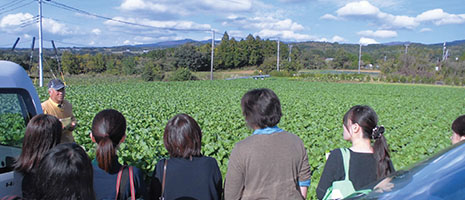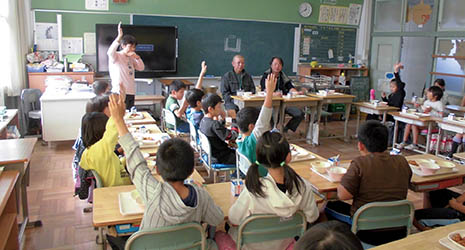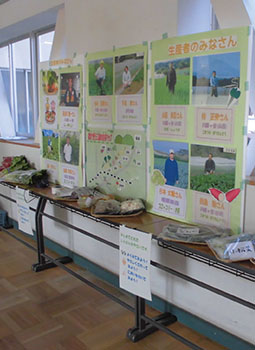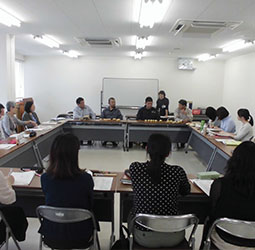Home > Highlighting JAPAN > Highlighting Japan May 2018 > Food and Agriculture Marketplace Potential
Highlighting JAPAN


Local Production for Local Consumption through School Lunches
Schools in Mishima, Shizuoka Prefecture have been supplying local produce for school lunches since 2002.
“IT all started with my invitation to go potato-digging to the students at the elementary school my daughter attended,” says Masahiro Sugimoto, an advisor of the Mishima Municipal Research of School Lunches Society for Agricultural Producers, a group that supplies local farm produce for school lunches in Mishima. The nutritionist in charge of the lunches was struck by the great taste of the komatsuna (Japanese mustard spinach) students also brought back and approached him to include the society’s products in the lunches.
“By coordinating among producers, we set annual prices, held meetings to check the size and quality of the vegetables, and invited nutritionists to tour the farms,” explains Masatoshi Hayashi, the chairman of the society. “We also created a system to deliver fresh vegetables directly to fourteen municipal elementary schools and three municipal lunch supply centers for junior high schools in Mishima.”
In 2009, Mishima began more actively encouraging using local produce for local consumption in school lunches, declaring itself a “city that promotes dietary education.” As of fiscal 2017, local produce accounts for 42 percent of lunches on nearly two hundred lunch days in Mishima. According to a survey by the Ministry of Education, Culture, Sports, Science and Technology, the national average in fiscal 2016 for incorporating local produce in school lunches was 25.8 percent.
With washoku (Japanese cuisine) at their core, Mishima's school lunch menus are designed to prevent lifestyle-related diseases, promote traditional Japanese eating habits, and help kids learn about their local food culture.
“There are around a thousand students in each grade at all the elementary and junior high schools in Mishima,” says Akira Hasegawa, the school education division chief in the Mishima City Board of Education. “So many students have been nurtured through school lunches made of local produce these past sixteen years. I believe that awareness toward local produce for local consumption, and the importance of washoku, has surely risen among every citizen, including parents of students.”
“I regularly have the chance to eat school lunches and talk with students at elementary schools, and sense an increased interest in agriculture among students,” Sugimoto says. “For example, they asked me about the best seasons for vegetables, how to grow them, and the difficulties of growing them. They told me they’ve started to track the varieties and prices of vegetables in supermarkets. Some even said they’ve started to help with farm work at their relatives’ homes.”
The school lunches featuring local produce have also had a positive impact on farmers.
“Along with contributing to the community, there is nothing more encouraging than being told directly by students that your vegetables are tasty,” says Hayashi. “And if washoku can become a fixture of children’s diets, it will also have a positive effect on the future of agriculture. It’s hard to be optimistic about the lack of future farmers to take over farms in Japan, but a younger generation is getting interested in agriculture in Mishima.”
“Maintaining a stable system for growing vegetables is essential to continue providing local produce for school lunches,” Sugimoto says. He works his fields and keeps the eyes of city officials and nutritionists on the fields as they ponder the best ways to ensure the production of safe and delicious vegetables.
© 2009 Cabinet Office, Government of Japan








